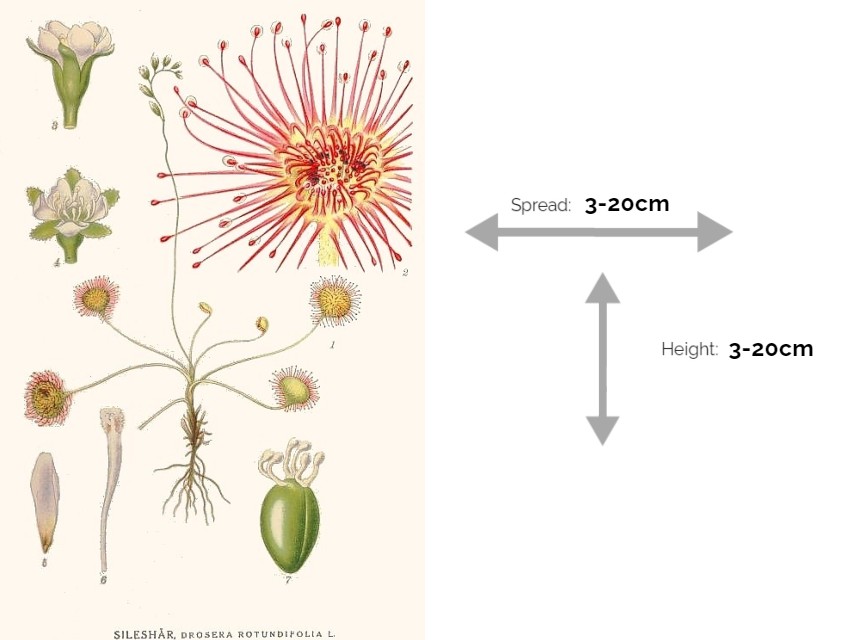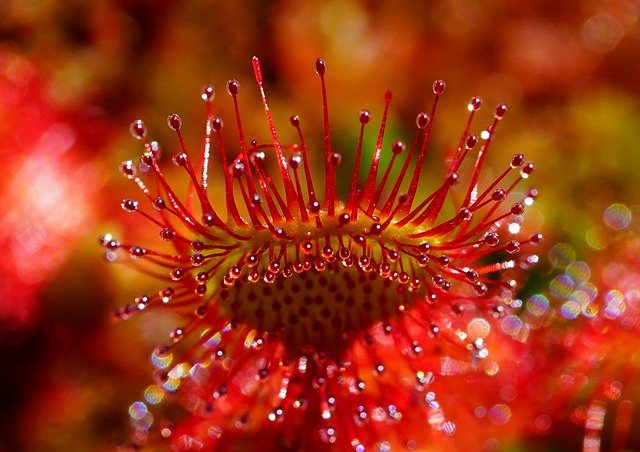A field guide on how to identify and propagate Common Sundew (Drosera rotundifolia), a zone 2 perennial shrub native to North America.

Hardiness Zone: 2-9

Soil Type: Acidic, Nutrient Poor Sand, or Medium Loam.

Water: High. (Only use Rainwater, Distilled Water or Reverse Osmosis Water)

Exposure: Full Sun to Partial Shade.
How to Indentify Common Sundew (Drosera rotundifolia)

Leaves

Drosera rotundifolia leaves are generally round, hence the species name “rotundifolia”. Sundew leaves are typically reddish in color and have long, drooping tentacles.
The tentacles or tiny hairs grow on leaves that are attached to a long stalk growing out from the center of the plant.
The tiny hairs secret a sweet, nectar-like, sticky secretion that attracts and catches insects, which provides nutrition for the plant.
Flowers

The flowers of Drosera rotundifolia are typically white or pink and are about 1 cm in diameter. They are borne on a short stalk and have five petals. The flowers are attractive to bees and other pollinators.
Flowering Season
Sundew flowers bloom from June to September but only during the day, one per day starting from the bottom of the inflorescence.
The flowers self-pollinate during the night.
Flower heads then turn into seed pods that become ripe to collect during late Fall.
Habitat
Sundew is a carnivorous plant that grows in wetlands and bogs. It typically grows in wet, acidic soil that is low in nutrients.
It’s found growing naturally in all of Canada and in the majority of the eastern and western states of the US.
Wildlife Value
Common sundew is eaten by a variety of herbivorous mammals like moose, deer, and is grazed by farm animals when found growing in fields.
It is a plant that interacts highly with insects. For example, the sweet sticky nectar it produces is food for the insects that avoid getting trapped in it.
Other insects like ants actually predate on the unfortunate ones that get stuck in the sticky substance.
Ants scavenge up to 2/3 of all insects caught in sundew.
Drosera grows and contribute to a wetland ecosystem that is the breeding ground of migratory waterfowls.
Other animals such as the endangered eastern massasauga rattlesnake live in swampy areas that are enriched by common sundews.
How to Propagate Drosera Rotundifolia
There are two great methods to propagate Drosera rotundifolia, that is by seed, or leaf cuttings.
- By Seed: Require harvesting ripe seeds late in the fall.
- By Leaf Cutting: When you take leaves and give them the right environment to form roots.
Here’s how to go about it:
Propagate Drosera by Seed
How to Harvest the Seeds
Drosera plants create numerous, small, smooth dark brown and spindle shaped seeds.
They’re ready to harvest from late Summer to late Fall.
Note: There is a timing for this because seeds left too long on the stalks will start to rot.
Here’s how:
- Cut the flower stalks off the plant when they’ve become brown.
- Place them in a tupperware, close it and shake it up.
- This should seperate the minuscule arrowhead-shaped seeds from the heads. (You can crush the seed heads to extract more.)
- Store them in a ziplock in a cold, dark place until ready to sow
Alternatively, you can order drosera seeds at rare exotic seeds.
How to Germinate Drosera Seeds
Drosera seeds can take from 1-2 months after sowing to germinate.
Here’s how to increase your chance of success:
Step 1: Cold Stratifification
Sundew seeds naturally go through a cold season outside, for success germinating the seeds, you’ll need to reproduce this process.
Put the sundew seeds it in a ziplock bag with 1:1 peat moss/sand, dampen it, tag it with name and date, then leave it in the refrigerator for 6 weeks.
Step 2: Sowing
After cold-stratification, surface sow (directly on top of the mix) the seeds in a 1:1 peat moss/sand mix.
Sprouts should come up within 2-7 weeks.
Eco Friendly Income’s tip: Use seedling starter trays with vented tops!
The link above is an amazon associates link. Please buy through our link to help us continue to provide quality content on plant propagation.
Seedling trays like this are perfect to keep the high level of moisture drosera plants need to start.
See end of article for drosera plant care.
Propagate Drosera Rotundifolia by Leaf Cutting
You will need drosera plants already to do this, but it can quickly multiply your droseras.
The best time to do this is when the plant is actively growing, from June to mid-September.

Here’s how to do it:
- Cut a whole leaf, or portion of a leaf from the sundew you want to propagate.
- Place your leaf cuttings in a soupy mix of 1:1 peat moss:sand.
- Use this propagation tub to establish new sundew plantlets.
- You won’t need to cover it as long as the soil is always soggy at the top.
- Place your propagation tub in a well lit area, grow lights are perfect if you can’t get great lighting.
- Keep the water level high until you notice new growth, or small roots protruding from the cutting.
- Finally, at this point you can gradually lower the level until the plantlets are completely established.
Keep humidity high and after 2 weeks-8 weeks, plantlets will emerge from the leaf cuttings.
How to Care for Drosera Rotundifolia Plants
Do not water carnivorous plants with tap water! Instead, use rainwater, distilled water or reverse osmosis water.
Drosera plants need no fertilization but they do need to be somewhere they can feed. A source of insect is necessary for their self-fertilization.
They should be grown in bright light, but with protection from full midday sun.
Drosera plants like cool temperatures, they should be kept between 20°C (68°F) and 25°C (80°F) during the growing season.
You need to keep their environment constatly humid, soil needs to be moist permanently. Do not let the soil dry in between waterings.
Sundew should be planted in short pots so the plants can stay close to the water level.
Humidity
A good tip is to place a pie pan with about an inch of water in it, under the pot. Next, elevate the pot by placing pebbles under it so that the base of the pot is barely in contact with the water, not submerged; the growing medium must stay moist, but never soggy.
This little trick will keep the humidity around the plant higher and it will ensure that it has a constant source of moisture.
The humidity for drosera needs to be between 60-80%.
Wintering
Drosera plants require seasons in order to survive long term. They need a dormant period of about 3 months in the Winter.
In the Winter, when food is scarce the leaves die back to form a tight resting bud, which is compeltely normal.
The typical heated home is too warm in the Winter, so duuring dormancy they should be kept cool and only damp.
The entire planter may be moved to an area where the temperature will remain below freezing point, down to -10°F.
It’s very important to protect your drosera from dry freezing wind during deep freezes. To do that, you can cover the plant with black plastic then uncover them when temperatures are warming up again.
That’s it! That should have you covered to identify and propagate drosera rotundifolia plants!
Want to propagate like a pro? Check out our plants propagation guide.



